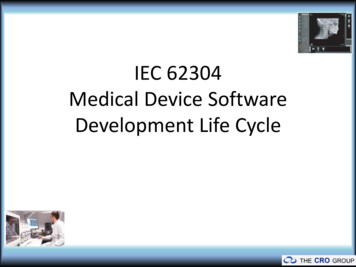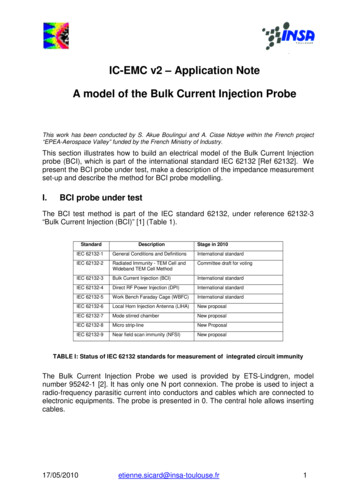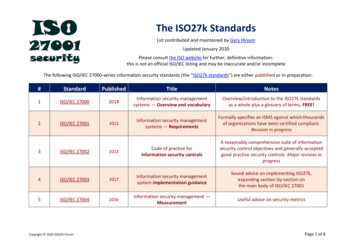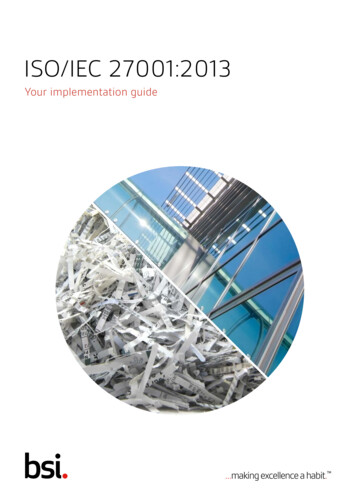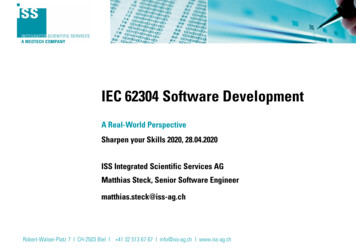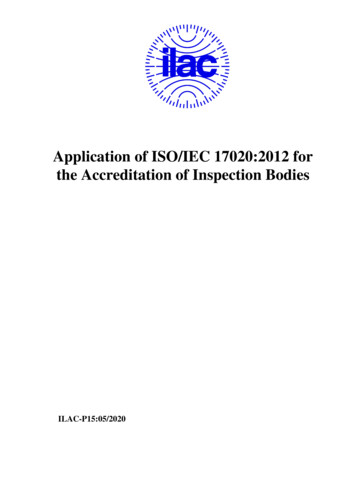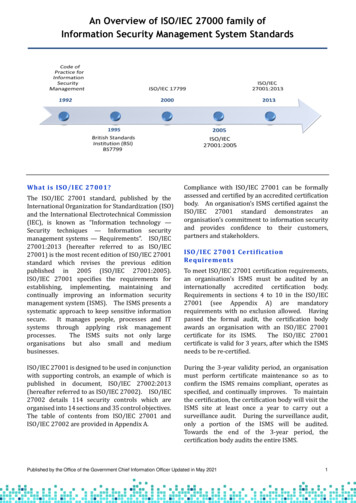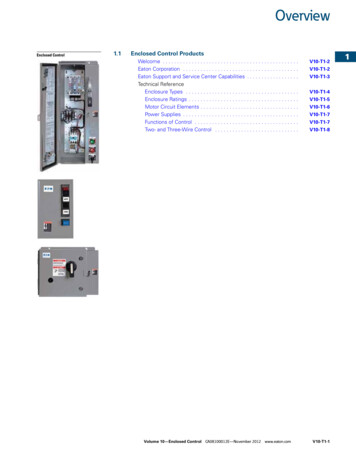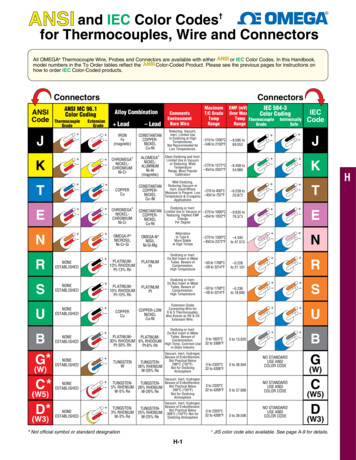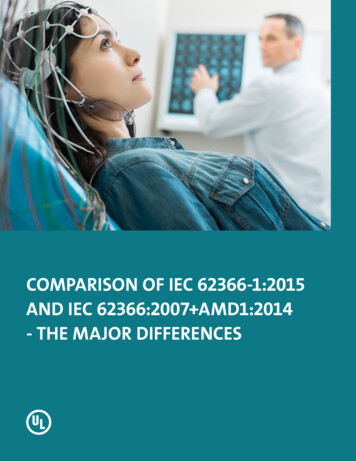
Transcription
COMPARISON OF IEC 62366-1:2015AND IEC 62366:2007 AMD1:2014- THE MAJOR DIFFERENCESpage 1
EXECUTIVE SUMMARYThe publication of the internationally harmonized usability standards IEC 62366-1:20151 and IEC TR 623662:20162 replaces the prior edition of the usability standard, IEC 62366:2007 AMD1:20143 . The new IEC62366-1 describes a contemporary usability engineering process that is somewhat streamlined comparedto the previously prescribed one. The new standard strengthens links to ISO 14971:20074 and the riskmanagement methods related to safety-related aspects of medical device user interfaces. While we areunable to share direct excerpts of the documents due to copyright limitations, the following provides a clauseby clause explanation of the changes.1IEC 62366-1:2015 Medical devices - Part 1: Application of usability engineering to medical devices2IEC TR 62366-2:2016 Medical devices - Part 2: Guidance on the application of usability engineering to medical devices3IEC 62366:2007 AMD1:2014 Medical devices - Application of usability engineering to medical devices4ISO 14971:2007 Medical devices - Application of risk management to medical devicespage 2
Clause 1: ScopeThe standard calls for the root cause analysis of use errors withincreased rigor and with a focus on severity of any potential harm(s) thatthe errors could cause. As such, the focus subtly shifted from meetingdiscrete acceptance criteria to reaching the point that a manufacturer isconfident that the level of residual risk is acceptable.Clause 2: Normative referencesThe changes are largely editorial in nature and are intended to clarifyhow referenced standards are applied. The only normatively referencedstandard is ISO 14971:2007, which remains unchanged from thepreceding standard.Clause 3: Terms and definitionsSeveral definitions have been added, modified, or deleted from thepreceding standard’s set. For example, the definition of primaryoperating functions now includes only those functions related to safety,removing reference to frequently used functions. In effect, this changemight eliminate the need to test certain primary operating functions(as defined in the prior edition) that are not safety-related. As such,individual definitions must be reviewed in detail.Clause 4: PrinciplesThis clause clarifies the linkage between IEC 62366-1 and both ISO134855 and ISO 14971. For example, IEC 62366-1 now states:“Where a documented product realization PROCESS exists, such asthat described in Clause 7 of ISO 13485:2003 , it shall incorporatethe appropriate parts of or reference the USABILITY ENGINEERINGPROCESS”; and also“.the interrelationship between the RISK MANAGEMENT PROCESS ofISO 14971:2007 and the USABILITY ENGINEERING PROCESS describedin this standard is shown in Figure A.4.”Note also that the third edition of ISO 134856 added further referencesto usability throughout the standard, strengthening the linkages evenfurther. As such, it is appropriate to review any Quality ManagementSystem and Risk Management System procedures to ensure thatproduct realization process linkages are established and documented,and that the Usability Engineering Process performed complies withapplicable requirements.ISO 13485:2003 Medical devices - Quality management systems Requirements for regulatory purposes6ISO 13485:2016 Medical devices - Quality management systems Requirements for regulatory purposes5page 3
Clause 5: Usability Engineering ProcessThe new standard clarifies the elements contained in a “Use Specification” as compared to a “UserInterface Specification” and both terms are new ones, replacing the arguably confusing terms “ApplicationSpecification” and “Usability Specification,” respectively.Now, “Frequently used functions” need consideration only when they are safety-critical, such as when afunction must be performed frequently for the device to be effective. Note that some countries may stillrequire compliance with the preceding version of the standard, so it might be desirable to retain the referenceto frequently used functions for an appropriate period of time.User interface characteristics related to safety must now be identified, similar to the ISO 14971 requirementto identify product characteristics related to safety. Primary operating functions and user interfacecharacteristics related to safety are then considered in the course of identifying potential use errors andscoping the summative (i.e., validation) usability test.The preceding standard only required consideration of “Frequent Use” and “Worse Case” scenarios. However,the new standard explicitly calls for the identification and consideration of “Hazard-Related Use” scenario.This new term is broader than “Frequent Use” and “Worse Case” scenarios, resulting in the potential needfor additional scenarios to be described, documented, assessed, and validated. Note that if a subset of thehazard-related use scenarios is selected for summative testing, justification for choosing the subset must bedocumented in the usability engineering file.page 4
Regarding the user interface evaluation plan, the new standard explicitly calls out elements to be includedin both formative (if applicable) as well as summative evaluations. Test protocols are expected to cover andindicate due consideration of elements such as the following: Participant selection in accordance with the identified, distinct user groupsTraining (withheld, delivered, or both)Learning decay period between (1) training and (2) device use in a usability test sessionSimulated environment equivalency to the actual environmentData collection approach and toolsPost-test analyses to be performed on such data as use errors, close calls, difficulties, anecdotalcomments, including responses to interview questions.Regarding products that move past planning and into actual design and implementation, the standardstrongly suggests that developers conduct iterative formative evaluations to refine and ultimately optimizethe user interface. The new standard reinforces the need to follow ISO 14971 to address other hazards orhazardous situations that may be discovered through iterative formative evaluations and resulting userinterface design changes.The requirements for summative evaluations reference and incorporate many of the new concepts introducedthroughout the standard. Importantly and as mentioned above, the standard no longer calls for theestablishment of discrete acceptance criteria. Instead, it calls for practitioners to perform intense root causeanalysis of all interaction problems (e.g., use errors, close calls, difficulties) that could lead to harm. IEC 623662 in particular encourages developers to hold users blameless for observed interaction problems and, instead,search for user interface design-related causes. This Technical Report Guidance anticipates that developerswill call upon a multidisciplinary team to determine if interaction problems that persisted in the validationusability test pose an acceptable or unacceptable level of residual risk. If the finding is acceptable, thenthe developer will likely want to freeze the given product’s design and seek regulatory approval for it. If thefinding is unacceptable, the product’s design is likely to require modification, which could involve changes tohardware, software, labeling, packaging, and/or training.Throughout the usability engineering process as prescribed by IEC 62366-1, there is a steady focus on userelated risk reduction. There is a high expectation that developers will use multiple approaches to identifypotential use errors, which could number in the hundreds for even simple products; that developers willdevelop user interface designs that are as inherently safe as possible; that developers will then implementadditional protections (e.g., guards, warnings, labels, instructions for use, training) that are as effective aspossible at preventing use errors that cannot be eliminated in a more fundamentally effective manner; andthat developers will validate that users can complete essential and safety-related tasks without experiencingegregious interaction problems that pose an unacceptable residual risk.page 5
CONCLUSIONIEC 62366-1 describes a usability engineering process that iscomprehensive and requires the investment of considerableresources and time, but is regarded to be an excellent meansto lower the risk of device-user interaction problems that couldlead to harm. The new standard has much in common with thehuman factors engineering (HFE) guidance issued by the US FDAand, as is true with its predecessor, we expect global regulatorsto leverage the work and expertise of those who updated thestandard. In a future article, we will explore the similarities anddifferences between the IEC 62366 standard and the FDA’s HFEguidance documents in more detail.For additional information, visit our website atwww.wiklundrd.com. 2017 UL LLC All rights reserved. This white paper may not be copied without permission.This paper is provided for general information purposes only andis not intended to convey legal or other professional advice.WITHIN THE UL FAMILY OF COMPANIES WE PROVIDE A BROAD PORTFOLIO OF OFFERINGS TO ALL THE MEDICAL DEVICE INDUSTRIES. THIS INCLUDESCERTIFICATION, NOTIFIED BODY AND CONSULTANCY SERVICES IN ORDER TO PROTECT AND PREVENT ANY CONFLICT OF INTEREST, PERCEPTION OFCONFLICT OF INTEREST AND PROTECTION OF BOTH OUR BRAND AND OUR CUSTOMERS BRANDS UL IS UNABLE TO PROVIDE CONSULTANCY SERVICESTO NOTIFIED BODY OR MDSAP CUSTOMERS. UL HAS PROCESSES IN PLACE TO IDENTIFY AND MANAGE ANY POTENTIAL CONFLICTS OF INTEREST ANDMAINTAIN IMPARTIALITY.page 6
This clause clarifies the linkage between IEC 62366-1 and both ISO 134855 and ISO 14971. For example, IEC 62366-1 now states: “Where a documented product realization PROCESS exists, such as that described in Clause 7 of ISO 13485:2003 , it shall incorporate the appropriate parts of
